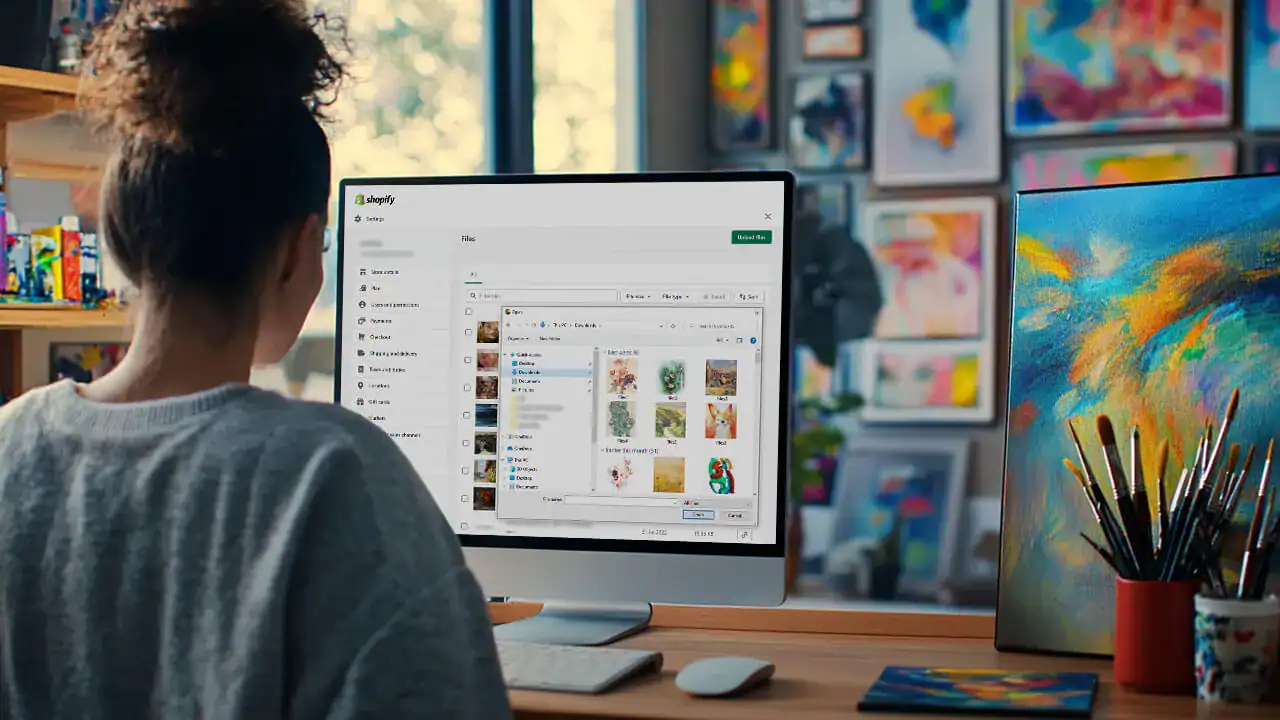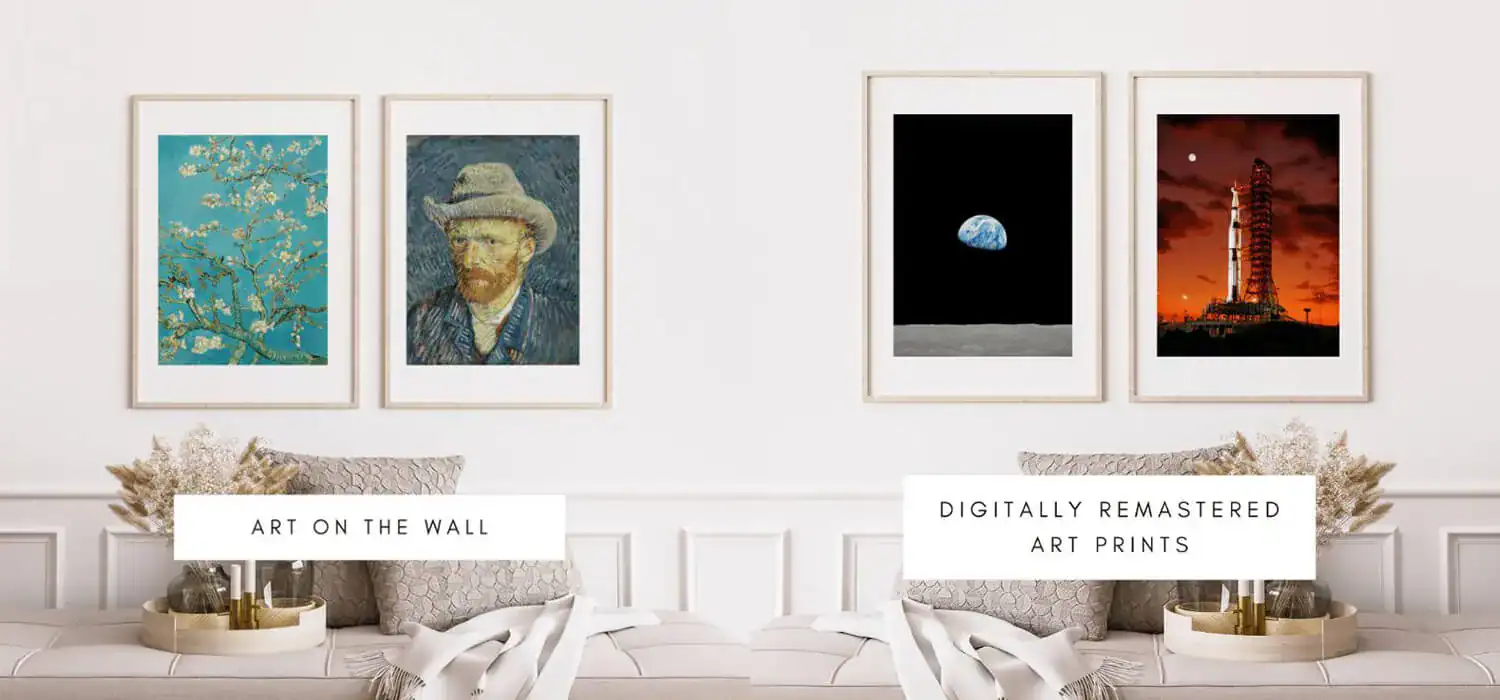If you’re an artist eager to sell your creations online, picking the right site can be a bit of a puzzle. There are a couple of well-known ecommerce platforms that cater specifically to artists like yourself.
Each offers a variety of features crafted to help you display your work and connect with your audience effectively.
Shopify is recognized for its user-friendly interface and extensive app store, simplifying the management of your online store.
Meanwhile, Squarespace captures attention with its beautiful website design templates, giving your digital art sales a visually appealing edge.
Shopify’s user-friendly interface for ecommerce platforms or the customizable options provided by other online store builders for digital art sales and website design.
| Feature | Shopify | Squarespace |
|---|---|---|
| Core purpose / focus | Built primarily as an e-commerce platform — designed to sell products online, manage inventory, shipping, etc. (support.finerworks.com) | Built as a general website/portfolio & content platform with e-commerce added on. Strong for showcasing work; store features are “nice to have” rather than its main strength. (Tooltester) |
| Ease of setup (for an artist non-techie) | Very capable, but the full feature set (apps, shipping, etc) may require more setup/configuration. (support.finerworks.com) | Very artist-friendly: drag-and-drop, beautiful templates, minimal coding required. Great for “I just want a portfolio + occasional sales”. (ALISSA SEXTON) |
| Design / Templates / Visual presentation | Good templates, plenty of apps/themes; however the visual/portfolio side may feel more “store” than “gallery”. Some artists feel the portfolio feature is weaker. (reddit.com) | Excellent: Strong “art / photographer / designer” templates, beautiful gallery layouts, image-first design focus. (Best Freelance Squarespace Web Designer) |
| Store / Sales Features (important if you sell prints / originals / merch) | Very strong: inventory, shipping, multi-currency, many integrations (print-on-demand, etc). Great for scaling a serious art business. (Gelato) | Good for moderate sales: you can sell originals/prints/merch, but fewer advanced store features (especially at scale) compared to Shopify. (theabundantartist.com) |
| Scalability / Growth | High: designed for growing businesses. More app/integration options, multi-currency, multi-locale, robust commerce features. (LitExtension) | Moderate: Ideal for small to medium business or portfolio + store. But if you expect heavy e-commerce, large inventory, many shipping rules, you might hit limits. (ALISSA SEXTON) |
| Portfolio / Gallery Features (for artists) / Presentation of work | Can do, but might feel more “shop” than “gallery”; may require more configuration or third-party apps to get a true “artist portfolio” feel. (reddit.com) | Very good: built-in gallery tools, great for showcasing artwork, with ease of use for updating and presenting drops, exhibitions, etc. (Best Freelance Squarespace Web Designer) |
| Cost / Pricing | Generally higher for full-store features; also transaction fees (depending on plan) unless you use all built-in payments. (LitExtension) | Usually lower-cost for smaller store/portfolio; fewer advanced features but lower entry barrier. (LitExtension) |
| International / Multi-currency / Multi-language Support | Strong: built for global sales, multiple currencies, etc. Good if you expect overseas buyers. (LitExtension) | More limited: international selling is possible but less flexible (one currency, fewer advanced shipping/customs features). (LitExtension) |
| Maintenance / Technical Overhead | Requires more oversight: apps, shipping integrations, customisations, etc might require more time. | Lower overhead: simpler setup, fewer moving parts, less “commerce” complexity = less maintenance if you keep it modest. |
| Best for which kind of artist / business stage | Best if you: anticipate selling a lot, have prints or merch, scaling up, need robust commerce tools, are comfortable with somewhat more setup. | Best if you: primarily showcase work, sell occasionally or modestly, want a beautiful site with less fuss, prioritize portfolio over full-scale commerce. (Gelato) |
| Weaknesses / what to watch out for | If you care primarily about presentation and less about complex store features, Shopify might feel overkill and cost more. Some say the “portfolio” aspect isn’t as seamless. (reddit.com) | If you grow bigger in e-commerce (lots of SKUs, heavy shipping, international orders, advanced inventory) you might outgrow Squarespace and need to migrate to something like Shopify. (ALISSA SEXTON) |
Ecommerce Platforms For Selling Art
Selling art online opens up a world of possibilities for creators. With various ecommerce platforms available, artists can craft a stunning artist portfolio that highlights their unique style.
Many of these platforms come equipped with customizable templates, allowing for a personalized touch that appeals to your audience.
Plus, with a mobile-friendly design, potential buyers can easily browse your creations from anywhere, whether they’re on a coffee break or lounging at home.
Don’t overlook the importance of SEO optimization; it plays a significant role in drawing traffic to your store. And when it comes to payment processing, robust options ensure smooth transactions, letting you concentrate on what truly matters—creating incredible art

What Shopify Is
Shopify is an all-in-one e-commerce platform that lets artists create a professional online store to sell art, prints, commissions, and merchandise — without needing coding or web-development skills.
It handles everything from website design, checkout, inventory, payments, and shipping to marketing and analytics.
What Squarespace Offers for Artists
Squarespace is an all-in-one website + e-commerce platform that emphasises visual presentation, ease of use, and building a brand around your art. You get hosting, design tools, a built-in store, portfolio templates, and marketing/SEO tools — all in one.
How To Choose Online Store Builders
Finding the perfect platform for your online shop can seem like a journey, but it can actually be quite enjoyable. Start by reflecting on what features you really need for your business.
Perhaps you’re looking for solid inventory management tools to keep track of your products effectively.
Or maybe you want robust marketing tools that can help you connect with buyers and boost your sales.
After pinpointing your must-haves, think about the overall user experience.
Is the platform easy to explore? A clean interface is a big plus, saving you time and helping you focus on your creativity. Also, consider the type of support they offer—especially important if you’re venturing into online selling for the first time.
Benefits Of Digital Art Sales
Jumping into the world of selling art online opens up a vibrant landscape filled with exciting opportunities. Global Reach:
Imagine your creations being admired by art enthusiasts across continents.
This approach helps break geographical barriers, allowing your work to find its way to customers who might never step into a local gallery.
How incredible is it to think of all those potential fans?
Low Overhead Costs:
Establishing a digital storefront typically translates to minimal additional expenses.
You can skip the physical space rental and those pesky utility bills. Plus, without the burden of handling shipping logistics, selling your creations becomes much simpler.
Just think about how much that could save you each month!
Another fantastic advantage is the social media integration that simplifies promoting your work
Importance Of Website Design For Artists
Your online presence is your chance to shine, showcasing your unique flair to the world. A thoughtfully crafted site can enhance how viewers experience your work, leaving lasting impressions that linger long after they’ve clicked away.
When someone stumbles upon your portfolio, the visual appeal creates an instant connection.
If the design grabs their attention, they’re more likely to stay, explore, and maybe even make a purchase.
It’s not merely about aesthetics—here, functionality meets creativity.
Easy-to-use navigation is crucial for artists looking to share and sell their pieces effectively. With an increasing number of people browsing on mobile devices, having a responsive layout is necessary for expanding your reach. If you’re considering adding blogging capabilities or an online marketplace, be sure to evaluate the potential transaction fees associated with print on demand services that support creative entrepreneurship.
Online Presence
- 70% of consumers prefer to learn about a company through articles rather than advertisements.
- Websites with a responsive design can increase mobile traffic by up to 50%.
- Visual content is 40 times more likely to be shared on social media than other types of content.
- Effective navigation can reduce bounce rates by up to 50%, encouraging visitors to explore more.
Is User-friendly Interface Essential?
Creating a captivating online space is more than just aesthetics; it’s about making sure visitors feel at home the moment they arrive. A thoughtful layout enhances the user experience right from the start, welcoming potential customers to explore your offerings.
When everything flows smoothly, your brand identity can truly shine without interruptions.
If your website feels complicated or clunky, chances are folks will bounce before they’ve had a chance to truly see what you bring to the table.
Keeping the design flexibility and straightforward is key to holding their interest.
Transitioning from the importance of displaying your artistry effectively, let’s dive into practical tips on how to craft an artist portfolio that not only looks great but also invites interaction and showcases your talent.
How To Create An Artist Portfolio
Building a collection to showcase your artistic vision can be an exciting adventure. First off, think about who will be checking out your work.
Consider what potential buyers or galleries are seeking in a selection.
Visual aesthetics definitely play a role here; your collection should reflect your artistic voice while also appealing to their tastes.
Choosing the right platform comes next, and it’s a big one.
Look for user-friendly website builders that offer product customization options, making it easy to tailor your portfolio just the way you like it. This way, you can share and possibly sell your artwork while making a memorable impression.
Now it’s time to focus on displaying your best pieces.
Select works that truly represent your style, and don’t shy away from showcasing diversity to catch different audiences’ interest. Each aspect plays a crucial role in enhancing the overall experience, from visual aesthetics to product customization, sales channels, artwork promotion, and marketplace comparison.
Building an Artistic Collection
- Understanding your audience can increase the likelihood of sales, as tailored collections appeal more to potential buyers and galleries.
- User-friendly website builders with customization options can enhance user engagement and improve the presentation of your portfolio.
- Diverse artworks in a collection can attract a wider audience, increasing the chances of connecting with different demographics.
- Effective promotion of your artwork through various sales channels can significantly boost visibility and potential sales opportunities.
Customizable Templates For Art Websites
Finding the right way to showcase your art can be a game-changer for any creative individual. Customizable templates offer a fantastic way to express your style while utilizing powerful design tools that make life a bit easier.
Imagine setting up a striking website tailored just for you with only a few clicks! This efficiency allows more focus on creating art rather than battling through complex codes.
Many of these templates also enhance user engagement, helping you connect with art enthusiasts and potential buyers effectively.
Choosing the right option can significantly elevate your online presence and enhance your art selling platforms
Comparing Payment Processing Options
When it comes to making your art sales a success, the choice of how to handle payments can really steer your journey. Each option provides its own set of perks that can align with your artistic goals.
Knowing the available payment gateways can help you ensure a smooth checkout experience for your customers.
Some artists might go for conventional processors, while others find that online solutions fit their style better.
Checking out customer reviews can offer insights into user satisfaction levels, which can be key in your decision-making process. Also, keep an eye on transaction fees; they have the potential to nibble away at your hard-earned profits. It’s also worth pondering how well these options mesh with your current shipping solutions since a seamless experience can significantly boost conversion optimization and enhance website performance through efficient payment gateways and positive customer reviews.
Payment Gateways for Art Sales
- Payment gateways can enhance the checkout experience, leading to higher customer satisfaction.
- Transaction fees vary significantly between payment processors, impacting overall profitability for artists.
- Customer reviews can provide valuable insights into the reliability and user-friendliness of payment solutions.
- Integrating payment gateways with shipping solutions can streamline operations and improve conversion rates.
Conclusion
It’s clear how important your choice of platform can be for art sales. A draganddrop editor can make setup a breeze, allowing you to focus on your artistic branding instead of the techy stuff.
Think about what features matter most to you and how each option can support your goals.
Pricing structures and content strategy will play a role in maximizing your earnings as well.
So, as you weigh your choices, remember to look for a platform that aligns with your style and nurtures your growth. Happy selling! With your drag-and-drop editor, artistic branding, audience targeting, content strategy, and digital downloads, you’re equipped for success.







